Most of us can’t find it on a map. But, yes, Virginia, there is a country called Uzbekistan.
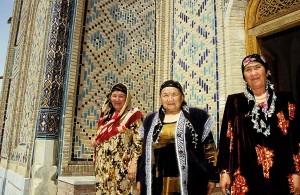
And – though it may be hard for us to find on a map – it was at one time one of the great trading thoroughfares of the world, and traveled by legendary explorers such as Marco Polo.
I traveled through Uzbekistan, too. And I can tell you that it’s a place of vast horizons and stunning sights, a place that overwhelms your senses.
Uzbekistan. The name itself is exotic, redolent of a distant, mysterious Asian culture half a planet away, and the tumultuous tides of history that have enveloped its people. It’s tucked away into the deepest heart of Central Asia, and enveloped in a swirl of mystical cultures. No place is more filled with mystique than the Old Silk Road…trod by princes and slaves, armies and empires, victors and vanquished, Oriental and Middle Eastern cultures, camels, and, apparently, Marco Polo, who wrote “The Travels of Marco Polo” here while on one of his famous journeys.
In fact, the Old Silk Road – which transported a lot more than just silks – may have been the ancient world’s primary commercial route, moving materials both mundane and treasured from the heart of the Orient to the shores of the Bosporus, and then sometimes on to Europe. Starting in China – yes, at first carrying mostly Chinese silk for trade – the road meandered through Central Asia, the Middle East, and into the Mediterranean Basin for some 4,000 miles.
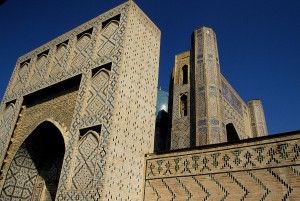
In addition to the silk, spices, jades, carvings, rugs, precious metals, pottery, and ceremonial objects that were carried west on the road, historians tell us that several other items eventually made the trip as well – among them, Buddhism and the Black Plague.
Human cargo? Statesmen, warriors, traders, holy men, adventurers, craftsmen, merchants, and more than one “Great Khan” have all left their footprints behind.
Uzbekistan is home to three of the most renowned Silk Road oases, whose very names seem to evoke the mystery of the ancient Orient – Samarkand, Bukhara and Khiva. And it’s home to one of history’s great stories. The Fergana Valley, according to legend, is where Central Asia’s silk production began…with two cocoons hidden in the headdress of a royal Chinese bride!
Now, you can create your own legends on the Silk Road. A Seattle, Washington-based company called MIR Corporation can take you on your own caravan, and into the heart of a Central Asia only recently opened by the fall of the Soviet Union.
You can stop in Tashkent, the capital of Uzbekistan. Tashkent is actually somewhat up-to-date. But the layers of ancient civilizations are always just under the surface here. For example, the Chorsu Bazaar is an Oriental market/bazaar/swap-shop that’s an intoxicating blend of colors, textures, sights, sounds, and aromas you’ve never experienced before.
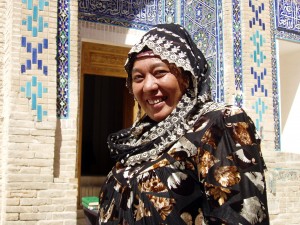
From Tashkent you’ll move to the fertile Fergana Valley, agricultural heartland of the country. Here, you’ll walk on ground once walked upon by Alexander the Great; here once stood a city he built in 329 BC. You’ll visit with craftspeople who create distinctive pottery and silk weavings at prices that practically beg you to take them home. And you’ll enjoy a home-cooked dinner, Uzbek-style, at the home of a local family. The cuisine and the surroundings are exotic, but the hospitality and the warm smiles are universal.
You’ll also stop at Samarkand, capital city of the great warrior called Tamerlane. Tamerlane’s armies carved a swath across Central Asia (and took very few prisoners!). You’ll walk on the blue-tiled ancient square called the Registan, and also visit a building in great contrast , the modern observatory of Ulug Bek. About 50 miles from Samarkand is the hometown of Tamerlane, Shakhrisabze (easier visited than pronounced!). Here you’ll visit the remains of the “White Palace,” built by another great conqueror who emerged from obscurity to leave a trail of destruction, called Timur.
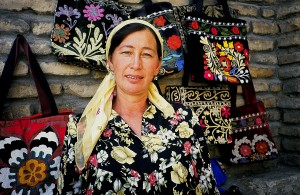
The Fergana Valley city may have been your first contact “with” Alexander the Great, but it won’t be the last. In the Kyzyl Kum Desert, you’ll see evidence of the fact that he was not only a conqueror, but also, apparently, something of an engineer. He constructed a system of wells in the reddish sands of this vast desert, so that his armies (and their animals) could replenish themselves on their way to new lands.
Here, on one of the highlights of this trip, you’ll get to ride a camel just like Marco Polo and the parade of great warriors who passed this way. You’ll spend a night in a yurt camp, where the language barriers will be broken by the traditional, still-warm Central Asian round bread just removed from the oven by the friendly residents. And, before you retire into your yurt for the night, you’ll sit by a warm campfire under a brilliantly-starred sky with no light pollution from the ground.
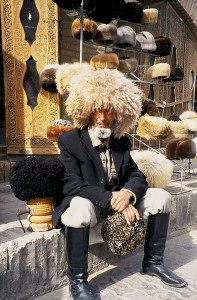
In the ancient trade center of Bukhara (where some of the best Oriental rugs in the world are woven), you feel like you’re back in ancient times, on dusty, colorful streets with thousand-year-old bazaars and homes and mosques made of mud. Here you’ll see the Kalon Mosque and Minaret.
You’ll stop, too, in Khiva, the last great oasis on the northern part of the Silk Road. Then you’ll move on to Nukus, known for a superb collection of Russian art that the Uzbeks somehow managed to hide from the departing Soviets in the early-90’s.
Some places stay with you forever. The Old Silk Road is such a place. The sun, the sand, the vast deserts, the mountains, the cities of mud, the history, the people…this is truly one of travel’s great experiences.
And truly a feast for the senses.
(All Photos Courtesy Mir Corporation)

